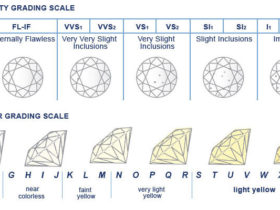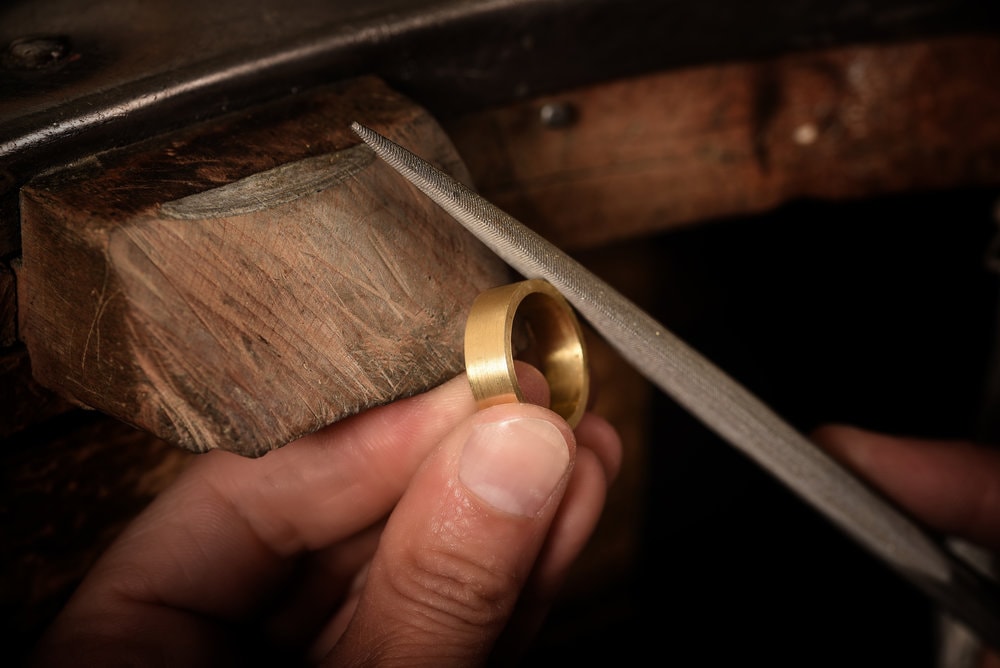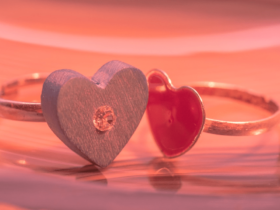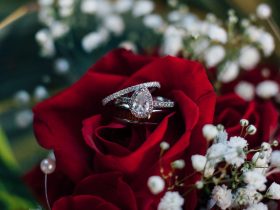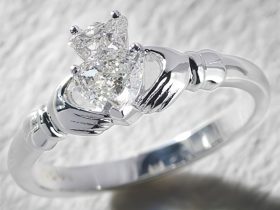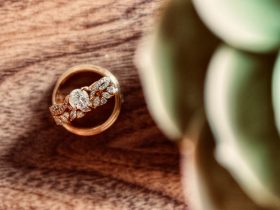When shopping for an engagement ring, more often than not, the stone — whether it’s diamond or other gemstones—- is our main considerations. However, the metal aspect of the ring is also a very important consideration: they add color, they will determine whether you have a shiny or satin finish, and for people with sensitive skin, choosing a hypoallergenic material is very important.
Here, we will discuss 8 of the most common metal options for engagement rings and their main characteristics, so you can make a better informed decision for your engagement ring.
8 Common Metal Options for Engagement Rings
Let’s start with the first one.
1. Platinum
Platinum rings have been really popular in the past few years for several reasons, but especially because of its hardness and natural white color that will never dicolor or fade.
Platinum is very rare, and is relatively more expensive than other choices, but is extremely durable and can last a lifetime. The best platinum metal is composed of 95% platinum and 5% of other pure metals.
Due to its strength, platinum is also the most popular choice for prongs, especially for a single-diamond center setting.
Unique Qualities of Platinum:
- Strongest, most durable choice available
- Resistant to wear and tear
- Beautiful, satin natural white finish
- Hypoallergenic, so totally safe for everyone
- Highest purity among other precious metals
2. Yellow Gold
Yellow gold is classic, traditional choice not only for engagement and wedding rings, but also for most jewellery. While it’s often branded as outdated in the past decade, yellow gold is currently making a comeback as the popular choice.
Yellow gold is usually available in 14k and 18k variants, although other karat numbers like 10k and 22k are also available. The higher the karat number, the more gold is included in the mixture, for example 18k gold is composed of 75% gold (the other 25% are pure metal alloys), and 14k gold composed of 58.3% gold. Obviously the higher the karat number, the more expensive it will be.
Unique Qualities of Yellow gold:
- Resistant to rust, although not as durable as platinum
- Very strong metal, and yet softer and more malleable than platinum
- Easy to maintain with minor polish
- Vintage, timeless color choice
- In most cases, more affordable than platinum
3. White gold
White gold metal alloy is a mixture of pure (yellow) gold with white metals such as silver or palladium. So, we get the strength and malleability of gold combined with the polished white color of the white metal.
White gold alloy is commonly plated with rhodium with two main benefits: it produces the brilliant white shine, and is also hypoallergenic. Rhodium does wear over time, so you will need to re-plate it every 2 or 3 years. The process, however, is relatively simple and affordable.
Unique Qualities of White Gold:
- More affordable option than the platinum if you want that white lustre
- Relatively durable thanks to its gold composition
- Rhodium is a strong protective plating that is also hypoallergenic and enhances lustre, will require re-plating after 2-3 years
4. Rose gold
Another popular choice nowadays as a more “modern” alternative to yellow gold. Often called red gold or pink gold, rose gold is a combination of gold and copper, with the “purest” grade being the 18k rose gold with 75% gold and 25% copper.
Rose gold retains the strength and flexibility of the gold, but is relatively vulnerable to scratches and wears. You can, however, re-polish the rose gold finish at any time.
Unique Qualities of Rose Gold:
- The iconic, modern pink-gold color is obviously the biggest reason of choosing a rose gold ring
- Relatively durable, but not as strong as yellow or white gold rings
- May dull over-time from contact with chemicals like detergents and moisturizers.
- Vulnerable to scratches, might need re-polish after a couple of years
5. Palladium
Palladium is often regarded as the more affordable option to platinum, since they share many similar characteristics. Palladium, like platinum, is a natural white metal that will stay white forever. Palladium is a little darker than platinum, but it’s hard to spot the difference.
One thing unique about palladium is that it’s actually the pursuit of the rare metals, where a palladium alloy can contain 95% of pure palladium.
Unique Qualities of Palladium:
- Durable, but lighter than platinum
- Permanent white color that won’t fade with wear, scratch-resistant
- Easy maintenance with simple polishing
- As with platinum, also hypoallergenic
- Won’t tarnish or corrode
- More affordable than platinum
6. Silver
One of the oldest rare metals used to make jewellery. Relatively inexpensive, yet very durable and malleable, making it one of the most affordable options.
The thing about silver, however, is that it’s easily scratched and tarnished, and some people are allergic to silver. To tackle this, a silver ring—as with white gold rings—, is often polished with rhodium to enhance its shin and to provide extra protection.
Unique Qualities of Silver:
- A very affordable option, yet won’t look that different from a white gold ring
- Easily tarnished and scratched, might need extra coating (usually rhodium)
- Very malleable and quite durable
- Due to its malleability, often used to add delicate design elements to white gold or platinum rings
7. Titanium
One of the strongest, most durable rare metals available today, and is naturally hypoallergenic. Titanium, due to its darker color and lighter weight, is more commonly used in jewellery for men, but is also a relatively popular choice for engagement rings.
Titanium doesn’t easily tarnish, and is relatively affordable.However, titanium is not very malleable and so very difficult to shape, so you might not be able to use complex designs.
Unique Qualities of Titanium:
- Very strong and durable
- Scratch and corrosion-resistant
- Darker color than white gold and platinum
- Naturally hypoallergenic and non-toxic, excellent for sensitive skin
- Relatively affordable
8. Tungsten
Tungsten-carbide is another very strong metal, but has a lustrous, shiny color resembling a mirror. Tungsten is exceptionally hard, so it’s also very hard to shape. Again, you might not be able to use tungsten for rings with complex design elements.
Very scratch-resistant, but very brittle. Avoid dropping a tungsten ring or it might easily break.
Unique Qualities of Tungsten:
- Very hard and durable, but also very brittle
- Shiny, mirror finish
- Hypoallergenic and non-toxic
- Scratch-resistant and non-corrosive
- Heavier than other options

